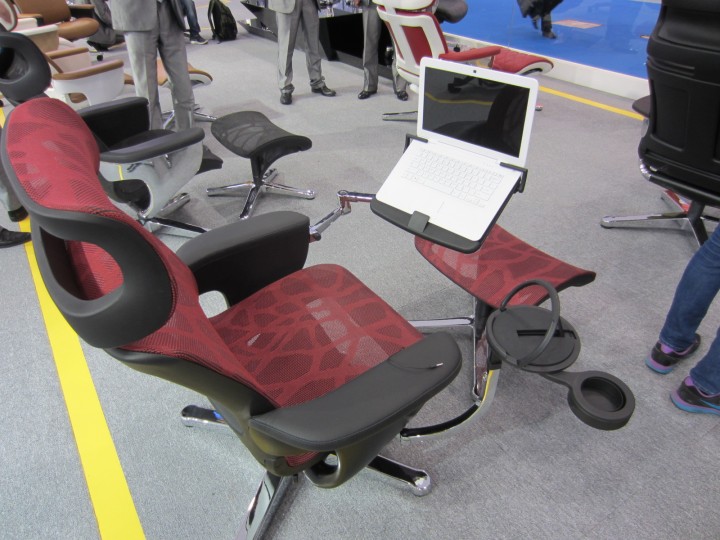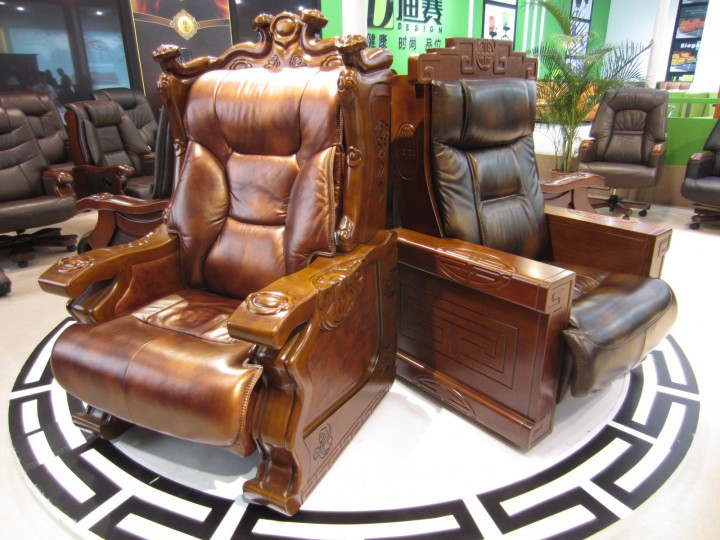
Adam Stoltz of HOK attended the China International Furniture Fair at the Canton Fair Complex in Guangzhou, Guangdong, China as a correspondent for Work Design Magazine. Here, he describes the trends that emerged at the show, which closed last week.
An American football field is 5,351 m2. CIFF vendors exhibiting office settings, chairs, and other office furniture accessories fill more than forty of them. Forty! In other words: An awful lot of black chairs.
But after I crisscrossed those forty football fields for a few days, certain themes began to emerge. Some ideas are new to the show for this year. Others are not, but seem to have evolved since their initial presentation in years past. On the other end of the spectrum, concepts driving furniture design in other parts of the globe are surprisingly absent.
Embedded Technology

Connections for every item imaginable have been embedded into chairs, tabletops, couches, you name it. Power sources, tablet and laptop trays, USB and other auxiliary ports and cords connect to speakers in chair headrests, arms, and backs. Even integrated Bluetooth connection points have been introduced to eliminate wires. It may not be long until the chair comes with a heads up display similar to that of your car dashboard to show the content from your Bluetooth-enabled device.
Biophilia
Nature and the ideas it inspires were represented throughout the show. Unfortunately, it seems to be one area where manufacturers and marketers are merely saying these things because they’re known to be popular, but fail to have a real understanding of what it means or why it’s important to them. One manufacturer tagline reads: “Dialogue between fashion and nature.” When I asked what items referenced this, the representative suggested that products found their inspiration from colors found in nature, and that the patterns represented the various branches of a tree. I was unmoved. Another boasts of “living in harmony,” though fell short of explaining how that translated to its line of chairs.
Tension Between Modernity and Traditionalism

For each sleek, slimline, European-inspired design move there seemed to be a contrasting presentation of old-world traditionalism towards furniture for the typical employee and furniture for the senior executives. This extended across design styles as well as within. It’s a fascinating tension, one not seen receiving as much significant attention in Western furniture concepts. In some cases, it’s clear that the intention is to offer the ability to maintain hierarchy without losing design quality and design consistency. In other cases, the offering is less successful and its intention less clear.
International Design Partnerships

For foreign manufacturers, providing style, quality, care, and comfort (plus Chinese manufacturing), and providing speed, efficiency, precision, and volume complement one another to make for a winning and growing combination. Hework and Boji are two examples of Chinese manufacturers producing furniture designed by European designers. AIKK is one manufacturer that, while not designed by an international partner, openly draws its design inspiration from international elements, such as the leg form of a table inspired by the Eiffel Tower in Paris.
Still others choose to establish international design credentials while working to avoid the negative stigma that follow the Chinese manufacturing industry. Okamura is one example of this. As a Japanese company, years ago they formed a partnership with an Italian designer and have deliberately chosen to retain manufacturing responsibility for themselves rather than with a Chinese firm. Their approach has been to import Japanese quality into the China market while they resolve concerns as to whether China can manufacture to their brand quality expectations.
Modern Workplace Practices in Talk and in Action

Many of today’s work practices, including considerations of employee flexibility, mobility, efficiency, access and awareness in the workplace, and activity-based work environments, have been exhibited through the furniture fittings available for years at CIFF. Certainly, these solutions are not new. In years past, however, while the furniture appeared to support modern work concepts, there was little understanding or appreciation, beyond market demand, for why manufacturers were doing it.
I asked many of the manufacturers of products that represented these concepts why these ideas were important and how their product fulfilled those needs. Fewer than half of those I asked had a clear story as to the meaning behind these concepts on display. Largely, these workplace practices and how the furniture supports them exist most frequently in taglines and marketing collateral. Only a few seem to understand these concepts well enough to describe the link between the idea and the product. In years to come I expect understanding of the true functional requirements of modern office concepts will spread more widely among manufacturers.
The sheer size of the CIFF and scale of China’s contribution to the global furniture market through manufacturing and design is, frankly, sometimes hard to fully grasp. And while their production leadership is unquestionable, their role driving thought leadership in the market shows certain room for improvement.


